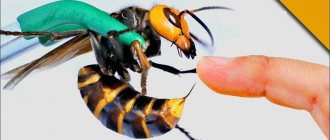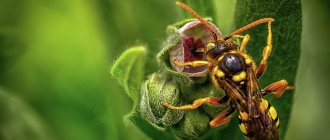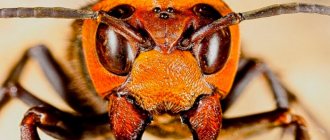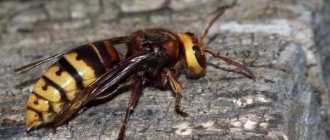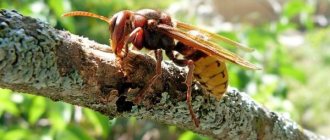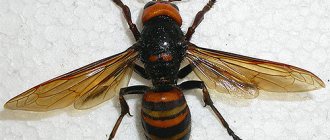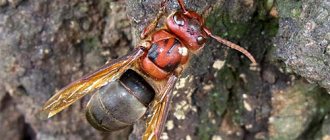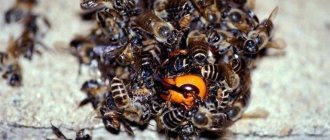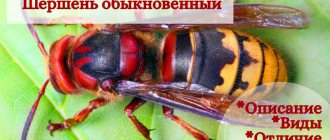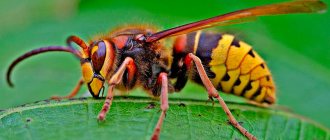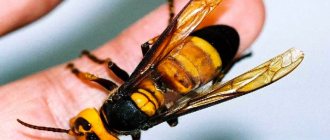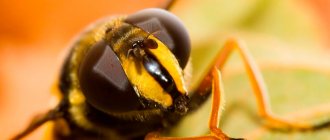Man is surrounded by a great variety of animals. Hornets are very familiar to us, but people don't like them. This insect causes fear, and sometimes panic and horror. It can attack a person and sting him painfully. Hornet venom can cause a severe allergic reaction, and multiple stings can be fatal. If anaphylactic shock occurs, immediate medical attention must be provided. At the same time, the hornet is useful. These individuals are excellent architects and builders! The whole question is what is our attitude towards them.
Hornets are social insects
People call them pirates. Other names are “winged corsairs”, “flying tigers”. This is what the biological classification of hornets looks like:
- class of insects (Insecta);
- order Hymenoptera (Hymenoptera);
- family of folded paper wasps (Vespidae).
The world has twenty-three types of hornets and many of their subspecies. In some European countries they are under state protection. So, for example, in Germany, a fine of 50 thousand euros is provided for the destruction of nests of such insects. The common hornet lives in numerous colonies or families, which include: females, males and workers. By the end of August – beginning of September, the number of colonies can reach 400–800 pieces.
There may be several females in a family, but there is only one hornet queen. At the same time, to prevent mating and the laying of fertilized eggs by other females, the main queen emits a special smell (Pheromone), and the secondary ones lay unfertilized ones, from which only drones hatch. Hornets settle in earthen nests, choose tree hollows, places under round roofs, and on fences for their homes. They make nests using saliva and chewing wood. The first spring generations consist of working hornets. Autumn - these are females and males. Only the fertile individuals remain for the winter. They hibernate.
The common hornet destroys its prey with a blow from its sting. Another way is to tear the victim apart with its jaws. Predators eat various insects, including nocturnal ones. The hornet kills a caught bee immediately and sucks it out. It carries the prey's breast to the nest to feed its brood.
During the day, a large family of winged predators catches up to 500 grams or more of insects. Hornets are very useful in the garden!
They feed on the juice of ripe fruits, trees and nectar of easily accessible flowers.
Protein food is necessary for the uterus for exhausting work - laying eggs. Hornets hardly sleep, they only freeze for half a minute about 20–25 times a night and do not move.
External appearance, features and photos of the hornet uterus
The queen hornet is the largest individual in the family. For example, the head female of the European hornet reaches a height of 3 cm, while the display of the working individual is much more modest - only 2 cm. However, these numbers are far from the limit: for example, in tropical hornets the uterus can reach up to 5.5 div.
In the photo - the head female hornet in the nest:
However, regardless of its serious size, the queen can easily be confused with a normal working individual: it becomes incredible that the leading female is alone in the field of view, and is located at a distance from the nest and is simply not visible. Who cares if it’s good or if it’s collecting useful material.
As a rule, the queen hornet flies at the beginning of spring, when she is tired of collecting urchins for her offspring, and finally in autumn, after a love battle.
On flowers, trees, and when caught in the living area, the queen hornet looks like a very large wasp. In the photo below, it is clearly visible that she has a typical aspen waist, characteristic black bandages on the stems with a brown base and a brown lapel at the appearance of a horseshoe on the back:
Thus, in most cases, the hornet’s uterus is as congested as all the other sacs of the nest. Even though unimportant in the great world, in the minds of the great avarice of working people, it will not be easy to know their queen.
In the photo - the hornet uterus at the center of the family:
Tse tsikavo
Using contrasting colors on barbed foundations, the original principle of visual masking is used. If a man wants to spite one person from a great group, the chaotic roc of hundreds of dark bodies creates a moodless storm in his eyes, in the midst of which it is important to see a specific victim. The monstrous example of this principle is zebras, who themselves wear a characteristic dark outfit. The hornets received the bark from their peaceful ancestors, the Bjils, who tried their best to protect themselves from the huts.
It means that the uterus of the hornet is not only similar to the members of its family - it is so “cut off” and stings with the same force as a working individual.
Dimensions and description
The anterior half of the uterine chest is yellow. The head has the same color. The first two rings are dark brown with yellow stripes, the rest are yellow with brown spots. The length of the hornet's uterus is from 25 to 35 millimeters. Males and workers are smaller in size.
The queen and workers have a sting - this is a modified ovipositor. At the top of the head on the sides there are three simple large compound eyes. The hornet has a reddish-orange color, and the cut resembles the letter C. The gnawing type mouthparts are equipped with very strong mandibles. The body is covered with hairs. For the development of ovaries and the production of eggs, the hornet queen needs food rich in proteins. For successful winter hibernation in August - September, the uterus feeds abundantly and accumulates the so-called fat body.
Cob of life of the uterus
The future founder of the new family of hornets appears in the light at the end of the sickle or the ear of the spring. A month before the birth of her mother, the old queen begins to lay fertilized eggs, from which the females emerge before breeding. At the same time, the old queen hornet lays unfertilized eggs, from which males hatch.
Until the mating period, the family of hornets is already very large: the number of working individuals in it reaches tens, or even hundreds. The same nest at this stage grows to significant sizes. So, for example, the body of a giant hornet can reach up to 70-80 cm and weigh up to 10 kg!
All larvae (including young queens) feed on the meat hedgehog and other mosquitoes. However, even after emerging from the hatchlings, the working individuals can continue to continue the family at any time.
Until the time of the appearance of females ready for reproduction, the old queen has already exhausted her potential and practically begins to lay eggs. Therefore, it is often caught in such a way that the robotic hornets drive them out of the nest or kill them.
In the photo there is an old queen of hornets:
When there are too many young females and males at the nest, stinks fly from the mother’s house, swarm and fuss. The males then die for several days, and the females can swim for many hours or pick licorice fruits for food. Despite the proximity of cold weather, they can still find what appears to be a place for wintering: under stones, in bark crevices, hollows, as well as in nests in which all the working individuals have already died.
Tse tsikavo
If the female has chosen a nest in the yak for wintering while the nest is being built, then it is highly probable that she will not live to see the end of winter. Encourage robotic hornets to live in old nests until the cold weather sets in, so as not to let the young ones fly back. There is also another reason for the low survival rate: sometimes in the nest, working individuals die off due to mites and bacterial infections, since young females are not spared and are found here.
The wintering stage of tropical hornets: after mating, the female immediately builds new nests. All the stinks sometimes return to the family, initiating the expulsion of the old queen, and begin to rule the already broken nest.
Life cycle and features of the existence of the hornet family
In the spring, at the end of May, the queen wakes up after hibernation. She makes reconnaissance flights in search of a place to found a nest. Having found a suitable one, he lays the first hexagonal honeycombs and attaches the subsequent ones to them. Soon, an egg will be laid in each cell, and after 8 days larvae will develop in them, and after 12–15 of them, as a result of metamorphosis, a hornet will appear.
Before breeding begins, the queen hornet identifies and purposefully lays eggs from which drones or future queens will hatch. This is controlled by the release of sperm.
By mid-June, workers will begin building the nest, and the queen will only lay eggs.
From September, young individuals appear. Since that time, the old queen hornet has been neglected. Her ability to lay eggs is significantly weakened, and those that are produced are eaten by workers within a few minutes. So the queen leaves the hive and dies at the age of about one year.
Female workers feed passive females and males. By absorbing large amounts of proteins and carbohydrates, the young queen acquires the necessary reserves for a long winter. Unformed cocoons are eaten by workers and drones.
Mating takes place in the fall. Royal young can be fertilized several times. Males die after two weeks. Fertilized queens look for a protected shelter for wintering. Diapause sets in.
At the beginning of November, the last of the working individuals die. Signs of life disappear in the hive. Most of the young queens will not survive the winter.
Wintering is the most difficult stage
During wintering, all processes in the body of a young female slow down, so she uses the energy reserves accumulated during the fall as economically as possible. However, a significant number of females die at this stage from frost and predators - insectivorous mammals and birds.
The most protected are those hornet queens that winter on trees under large layers of bark: birds cannot always penetrate under them, and there are not many other insect hunters at this time.
The photo shows a hornet queen during wintering in a gap between logs:
Hornets - builders and architects
When a hornet nest is established, the insects use rotten wood. It must be chewed and mixed with saliva. Honeycombs are built from the resulting substance. The shell of the nest also consists of it. Glue is also saliva. The dried surface is analogous to corrugated paper. The color depends on the type of wood. The nest is not used for the second year. After winter, in the spring, the queen finds a convenient place for a new nest. She attaches a small leg to the ceiling. The first honeycombs are made on it. The expansion of the home always occurs from top to bottom, the entrance is in the lower part. A large hornets nest has 6 tiers. The largest ones reach half a meter in diameter.
Vespina
The most organized species of wasps belong to this subfamily. They are distinguished by complex behavior and nest architecture. Insects are distributed throughout Europe, Russia, northern Africa, America and Australia. A distinctive feature of representatives of the Vespin family is a large number of hairs on the body and the shape of the abdomen, chopped off at the base. A colony is characterized by the presence of only one queen. This is a fertilized overwintered female. The differences between the castes in the family are very distinct; the size of the wasp uterus is one and a half times larger than that of the working individuals.
Socket device
Queens establish nests in shelters (natural or built by humans). The building material is bark removed from branches and rotten stumps. With strong jaws, the female scrapes off wood fibers. Having gathered them into a ball, she flies to the place where the nest is built. The fibers are chewed again and abundantly moistened with saliva. The wasp attaches the lump to the wall and carefully stretches it into a strip. A protective wall is formed from many strips fastened together.
Paper wasps build two types of nests:
- gymnodom - with open honeycombs;
- calyptodomous - structures that have a protective shell.
The construction of a vespin nest occurs in several stages. At first it resembles a bowl in shape, and then a sphere. In spring, the structure is so small that the queen cannot accommodate herself in it; at night she settles on the stem of the nest. Protective shells are created one above the other; when the structure expands, the inner shells are chewed off.
Hexagonal honeycombs are arranged horizontally, and the wasp larvae hang upside down in them. The number of tiers ranges from 3 to 10. The first honeycombs are built by the queen herself; after the appearance of working individuals, she stops foraging. The queen's solitary residence lasts 1 month. When working females grow up, all concerns about food and nest building pass to the offspring. Adult vespins feed on flower nectar, sweet syrup, and juice of ripe fruits. For the larvae and queen, they catch insects - flies, beetles, caterpillars, slugs, butterflies. Wasps chew off the hard body parts of their prey and bring the fleshy part back to the nest.
There is a strict distribution of responsibilities between the working individuals - some bring food for the queen and larvae, others guard the colony and care for the growing offspring. On hot days, insects vibrate their wings for ventilation. After the young individuals leave the honeycombs, the cells are prepared for a new egg.
Vespins live in huge families, including thousands of individuals. Their nest is constantly expanding by adding new honeycombs, suspended from a central leg. The wasps lay eggs in the cells, from which larvae emerge a week later. By mid-summer, males and hundreds of young females appear in large cells, ready for fertilization.
The mating season occurs in August-September. At this time, the wasps are excited and often aggressive. Anyone who approaches their nest will be attacked mercilessly. After mating, the males die, and the old queen will also not survive the next winter. Young fertilized queens find shelter for the winter. The life cycle of the Vespin queen is 1 year, workers live 1-2 months. Some species of Hymenoptera insects are active until the beginning of winter. Working females of the common wasp (Vespula vulgaris) and the German wasp live in the nest until cold weather.
This is interesting: Meadow bluegrass: what is it
Alarms
Just like other insects, hornets are able to unite as a whole nest and sting the enemy for self-defense. It is very dangerous! Feeling threatened, the hornet releases an alarm pheromone. This substance activates its fellow creatures to attack. You should not kill the hornet near the nest. Distress signals can raise the whole family to take revenge on the offender.
The trigger signal for an attack can be various materials that, due to their chemical properties, can come into contact with the pheromone, including clothing, skin, and food seasonings.
Dream Interpretation - Bee
To bad weather. Bees hovering over your head mean victory, triumph, success. Keep bees - you will get joy from your wife and earn your living with honest work. Seeing bees attacking means an epidemic, pestilence. To kill a bee means to experience obstacles, hindrances. A hive with bees - dreams of wealth. An empty hive means receiving punishment without guilt. Bees swarm in a dream - the matter will not end in success. Bees sting your leg - to the joy associated with material gain and acquisition. A swarm of bees - take an orphan into a home; this dream can also mean the ruin of a family. Stung by a bee - for a young woman to become pregnant. A beehive in a dream means big profits, increased income or higher wages. An apiary filled with buzzing and hard-working bees in a dream means that your work is more useful for others than for yourself. They saw the apiary and were on it - to receive good news by mail.
Wasps
In scientific Latin, the hornet is an insect designated as Vespa - "wasp". Vespula – denotes a common genus of wasps (literally translated as “wasp”). In science there is a clear classification of this type of insect, but in real life there is confusion when distinguishing between large hornets and other representatives. True wasps are smaller and have a bright yellow and black coloration, while the hornet is a darker-colored insect.
There are large wasps called hornets. A special place among them is occupied by the spotted Dolichovespula Maculata. She lives in North America. In English it is called a Bald-faced hornet, just like real hornets. It has black color and ivory stripes. Most likely, wasps are called hornets because of their habit of creating above-ground nests. There is also the Australian hornet Abispa Ephippium, a species of solitary wasp.
Bee construction
The process of building a bee hive is slightly different, although it also begins in the spring. When bees awaken from hibernation, special glands begin to produce wax. It is this, and not the bark, like in hornets and wasps, that becomes the material for honeycombs. A unique material is wax; bees spend a huge amount of honey to produce it.
Who is the common hornet: what is the difference between a wasp and a hornet?
By renewing old cells in the hive, the bees immediately build new ones and begin to fill them with honey. The construction talents of bees are also surprising, as they build cells of the same size and geometrically correct shape.
Benefit or harm?
In literature about the forest, the hornet is often presented as a dirty trick that needs to be neutralized, since it gnaws the thin bark of trees. Because of this, curled branches are formed that die. This damage, compared to that caused by other wild animals, is very insignificant. It's good to have a hornets nest in your garden or vegetable garden! Interesting fact: in one day, a large family of predatory insects can destroy more than five hundred grams of harmful insects. They catch live prey and rarely take carrion!
But these are the main natural enemies of ordinary worker bees. The voracious large hornet and his fellow giants swoop down on bee nests to feast on their honey and larvae. Among the famous cases: thirty large hornets destroyed 3 thousand bees in an hour and a half. Hornets crush their prey with their powerful jaws. Bees have also developed methods of protection: carbon dioxide and heat. Getting into a “bee ball” with a high temperature, the hornet will be killed by workers in ten minutes. In addition, the concentration of carbon dioxide in the ball increases sharply.
Interesting Facts
The Japanese giant hornet has three eyes at the top of its head. Giant hornets build multi-tiered nests, the base of which looks like gray paper. The largest is the Asian Vespa mandarinia. In Japan it is called "sparrow bee" or "tiger bee".
During wars, Asians bombarded the enemy with hornet nests, thereby causing panic in their ranks. Compared to the European, large individuals of the Asian representative are less aggressive.
Where do they live?
The Asian giant hornet lives on the territory of the Japanese islands, India, Korea, Nepal, in the mountains of Sri Lanka and Taiwan. Found in the Primorsky Territory of Russia.
giant hornet head
Japanese hornets are found only on the islands of Japan; you will rarely see them on Sakhalin. The primary habitat of hornets is the subtropics of Asia and America, southern Europe.
What do they eat?
Giant hornets are quite unpretentious eaters. They are big lovers of sweets - they eat soft fruits, berries, honey, nectar.
They also destroy other insects: locusts, grasshoppers, flies, butterflies, crickets, bees and other representatives, as well as eggs from which new insects will hatch. They kill victims with the help of powerful jaws in front of the head, carefully treat them with saliva, chew them and take them to their larvae to be devoured. Adults do not feed on insects. The larva feeds on processed insects, meat and fish from the trash heap, and dead insects. All of the above food is delivered to her by an adult hornet.
Methods for destroying hornet nests
The Japanese giant hornet cannot tolerate the aromas of sulfur and ammonia. Therefore, throwing a rag soaked in ammonia over the nest, drive out the inhabitants. You can use sulfur to smoke out giant hosts.
giant hornet nests
The easiest way is to quickly dip the nest in a container of water. The nest will become wet and not a single individual will leave it. You can remove the hive using fire; just bring a match to the nest and it will instantly flare up. Traps made from bottles of sugar or sweet water are relevant.
How to get rid of hornets in your garden?
Unlike other wasps, hornets are difficult to lure with honey baits or jam. They begin fighting in early spring. At this time, the wasps are in the initial stages of building their nests. First of all, all buildings are inspected, especially those rarely visited.
Found nests are sprayed with potent insecticides, and then removed and burned. When they are big it is difficult. Baits made from minced meat and fish, poisoned with pesticides, are effective, which hornets often use to feed larvae. They are placed in places inaccessible to pets. Various sweet traps are made for adult insects, especially with beer or fermented kvass.
Nutrition
The diet of these insects consists mainly of foods with large amounts of sugar and fructose. In addition, hornets consume the sap of trees and some insects.
Having killed the prey with poison and processed it with their jaws, these insects secrete a suspension with which they feed their larvae.
Why and how is the hornet dangerous?
For humans, the venom of most hornet species is less toxic than that of bees. After the injection, the sting remains in the wound. But this insect can sting several times in a row. The deadly properties of the poison are due to the high concentration of mandorotoxin and toxic substances that cause destruction of the tissues of the human body.
If the hornet releases a lot of poison, a serious inflammatory reaction will occur. How dangerous is a hornet to humans? With high individual sensitivity, the consequences can be very serious. If there are many injections, as happens when a hornet nest is disturbed, death is possible. Japan has bleak statistics: about forty people die every year after being bitten by a giant hornet. The venom of Asian individuals is highly toxic. European individuals are smaller and not as poisonous. According to the special Schmidt sting pain scale, the pain from a hornet bite is approximately comparable to that from a honey bee and is located at the middle level of the scale, as moderately strong.
As a rule, fears of a hornet are exaggerated: its bite is disproportionate to the size of the insect.
It is important to know!
When destroying a nest using insecticides, make sure that children and animals do not inhale dangerous fumes.
When destroying a nest, prepare an escape route. Because if you fail, you will have to leave the area very quickly, otherwise you risk becoming a victim of an angry swarm.
If you are not confident in your abilities, contact a specialist.
And if the hornet does bite you, take the following measures. First, remove the stinger using tweezers. Then disinfect the bite area. You should also take an antihistamine tablet to avoid an allergic reaction. If after all these steps your health condition worsens, immediately go to a medical facility or call an ambulance.
Good luck in this difficult pest control.
Hornets are natural predators that can significantly reduce the number of garden pests. However, proximity to such insects makes a person constantly worry about the possibility of being bitten. Hornets often create their nests in close proximity to human habitation: in attics, gazebos, and verandas. Such a neighborhood is generally life-threatening. Therefore, you need to know how to properly destroy dangerous insects and destroy entire nests.
GRASSHOPPER
Almost seven thousand species of grasshoppers live on our planet. They live on every continent except Antarctica. Grasshoppers are colored green or brown, which serves as an excellent camouflage for them. They are not at all visible in the thick meadow grass.
Grasshoppers have very powerful, long hind legs. With their help, they can make very long jumps, which will be the envy of other recognized jumpers of the animal world. Grasshoppers jump a distance of 40 times their body length. In Malaysia, there is a grasshopper that is 25 centimeters long and can jump 5 meters!
Grasshoppers are unusual insects. Their hearing organ is on their legs, and they rattle... with their wings. Each type of grasshopper chirps differently. As a rule, only males can chirp, but there are species in which females also chirp.
Some grasshoppers feed on plant foods - they eat grape leaves, flowers and buds, they love tea bushes and citrus plants. Other types of grasshoppers feed on small insects - flies, small butterflies and their caterpillars.
In summer, the female grasshopper lays 70–100 eggs in the ground. In the spring, the larvae hatch from them. They are green in color with a brown or blackish stripe on the back.
In our country, the most common grasshopper is the green one. The steppe part of Russia is home to the steppe grasshopper, one of the largest grasshoppers. The length of its body reaches 6–8 cm. In its habits, the steppe rack is more reminiscent of a praying mantis. She can sit motionless in the grass for hours waiting for prey, which she catches with her front legs. The rack feeds on large insects - locusts, crickets, beetles and bedbugs.
The warty grasshopper got its name because it was used to remove warts. The grasshopper was forced to bite a wart and secrete healing saliva onto it.
This little violinist
Emerald wears a cloak.
He is also a champion in sports,
He can jump deftly.
(Grasshopper)
External differences
Despite the fact that wasps and bees belong to the same order Hymenoptera and are essentially related, they have many differences
We will not take into account exotic types of flyers and consider:
- common types of paper wasps;
- honey bees;
- hornets - typical representatives of social wasps;
- bumblebees are ambassadors from the family of real bees.
Color
You can identify the difference between a bee and a wasp visually by their appearance. The color of the bee is muted yellow with black stripes. The body is covered with hairs.
The wasp is distinguished by a smooth body without signs of hair, rich yellow and contrasting black stripes. The bright “robe” of the insect is noticeable from a great distance. But the wasp does not need thick hair, because collecting nectar is not its main business.
The color of the body is one of the main signs of difference between a bee and a wasp.
Body structure
It is not for nothing that the wasp is famous for its wasp waist - the interception between the abdomen and chest. In the photo, the graceful curve is visible especially clearly. The body shape is elongated and elongated. Upon closer examination, powerful jaws and thin legs stand out. The hornet is very similar in appearance to the wasp, but only with more developed jaws and a thicker waist.
The bee has a more rounded body and the interception between its parts is barely visible. Compared to the wasp, the proportions are harmonious. The abdomen differs in shape depending on what level the insect occupies in the bee hierarchy. In honey-bearing workers it is egg-shaped, in the queen it is elongated, and in drones it has a blunt ending. Unlike wasps, bees have so-called baskets on thick legs - containers in which they place flower nectar.
Lifestyle, main functions
The behavior of a fertile female and the lifestyle of different species of the wasp family differ, but the main mission - prolongation of the genus - remains the same.
Single queens
They are active in early spring – the mating season begins. Eggs begin to be laid in summer. Before this, they live for their own pleasure - collecting nectar from plants, drinking juices of fruits and berries. They do not form multi-tiered nests; they dig holes in the ground for laying eggs.
The queen prepares the nest in light, easy-to-digging soil. The depth reaches 5 cm; a single cell is located at the bottom.
The female paralyzes the larvae of large beetles, spiders, and various insects, drags them into a hole, and lays an egg on the body. After a few days, a larva appears and devours the victim within 14 days.
In this way, the queen provides the larva with separate housing and food. At the end of the cycle, pupation occurs. In the pupal state, the larva overwinters; in the spring, young females and males independently emerge to the surface, and the mating process begins.
Public vespins
The Wasp Queen is the founder of a large family, within which there is a clear hierarchy. The majority of the society consists of working individuals - immature females. They build a nest, provide protection, look for food, and feed the larvae.
Queen wasp of public vespins
The young queen lays the foundation of a nest in a favorable location. Initially forms a leg, then lays out the honeycomb. An egg is laid in each cell. After 3-4 days, sedentary larvae appear, which need to be fed for 2 weeks. The queen hunts spiders and insects, since the cubs require protein food. Chews, forms balls, gives to larvae.
At the end of the cycle, the larva pupates, after 2-3 days a working individual appears, to which the queen entrusts all responsibilities for building the nest, searching for food, and caring for the larvae. She herself becomes the queen of the family, only laying eggs.
In August, large honeycombs are built near the nest, where special eggs are placed. From them a generation of young sexually mature females and males appears. They live in the nest for some time, come out in the fall, and mating occurs. With the onset of cold weather, working individuals die, females find refuge in wood for wintering.
According to some sources, the former queen dies in November, according to others, she hides and spends the winter. Forms a new family in the spring and has the ability to return to its original places. From here the queen's life expectancy is calculated from 1 to 2 years.
Paper sheets
They occupy an intermediate place between primitive solitary wasps and social vespins. There may be several mature queens in one nest, but only one plays the role of queen. The rest help her increase the population size. The number of hives reaches several hundred individuals. Otherwise, the functions of the uterus are identical to vespins.
Paper wasp queen
In nature, there are many species, subspecies, and genera of wasps. Among them there are predatory queens or parasites that sneak into someone else's nest, kill the true queen, and take her place. The enslaved family cares for the larvae of the new queen, feeding her herself. Over time, only her offspring remain in the hive.
